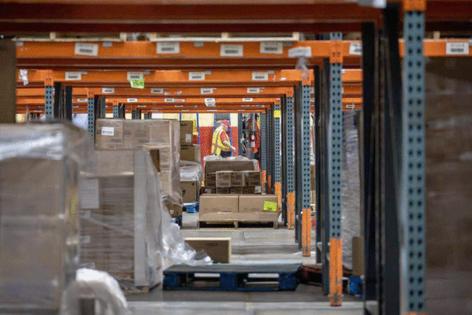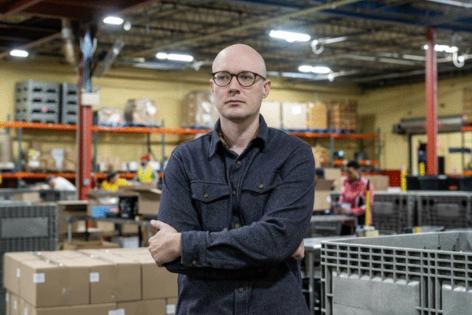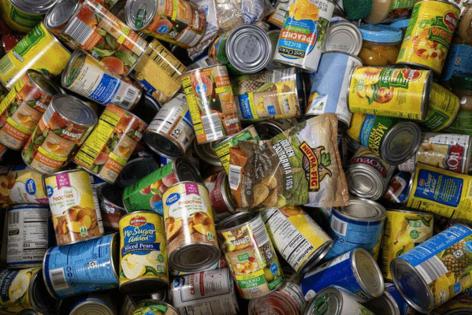As SNAP shutdown looms, this food bank grapples with bare shelves, rising need
Published in News & Features
KANSAS CITY, Mo. — Rows of shelves inside a warehouse at Harvesters’ Kansas City headquarters are nearly bare, no longer full of canned vegetables, soup and rice or protein drinks for seniors.
They’re refilled each day as best as they can be. But in recent days, as the nation suffers through the fourth week of a government shutdown, it’s getting harder for the local food bank to keep them stocked.
“We have a lot more empty shelves than we normally do,” said Matt Hamer, Harvesters’ communications manager.
He and Elizabeth Keever, Harvesters’ chief resource officer, know that’s only going to get worse, as recipients of the Supplemental Nutrition Assistance Program (referred to as SNAP and known as food stamps) won’t be getting their November benefits. The U.S. Department of Agriculture announced on its website that assistance won’t go out the first of the month like it normally does due to the shutdown.
And the benefits are not expected to pick back up until the shutdown ends or a temporary solution comes. This leaves Harvesters, and other food banks like it across the nation, scrambling to address how they’ll support pantries and other partners when SNAP recipients go looking for meals.
“It’s all hands on deck right now,” Hamer said. “We’re using the same team that we do if there was a natural disaster.”
The SNAP program serves about 42 million — 1 in 8 Americans — nationwide. There’s never been a full shutdown of these benefits since the start of the program, Hamer and Keever said. It goes back to the 1960s when the food assistance program was first piloted, according to the USDA website.
For the past two or three weeks, as the shutdown waned on and reality set in that SNAP benefits wouldn’t be distributed in November, staff members at Harvesters have been working to address what they can . The food bank serves 27 counties in Missouri and Kansas.
“The problem is,” Keever said, “you can’t out-fundraise this problem.”
‘Sounding the alarm’
In Jackson County alone, $19 million in SNAP benefits won’t be distributed in November. That’s just one month, Keever said.
And more than what Harvesters raises in charitable donations for an entire year, she and Hamer said.
What people don’t realize, Hamer said, is the magnitude of what will be lost when this assistance isn’t distributed.
For context, Hamer said, every meal that Harvesters provides, SNAP benefits provide nine. There’s “no mathematician on earth,” he said, that “can make sense of that.”
“There’s just no way that the charitable food sector can take on everything that we’d be needing to take on,” Hamer said. “We’re just focused on trying to get as much food to as many people as we can, and kind of sounding the alarm that, ‘Hey, this is a prolonged shutdown (and) is not sustainable, and we call upon the public to help us out.’
“But again, we know that there’s no amount of community support that can make up what’s being lost right now.”
In Missouri alone, about 650,000 are facing a November without the food benefits. And in Kansas, nearly 188,000 residents will be without the assistance if the shutdown continues.
Jury Paulson, director of community impact at Harvesters, said agencies partnering with the food bank — including pantries, shelters and soup kitchens — are anxious and “maybe a little bit fearful” right now.
“The lines are only going to get longer at our partners’ doorsteps,” Paulson said. “And there’s just literally not enough resources to meet an increased need. There’s barely enough resources to meet the need prior to the shutdown and federal workers getting laid off and benefits ending.”
To try to help address that, Harvesters has reached out to some of the larger pantries in Kansas City and asked them if they can “take on more during this time,” Hamer said.
Once the shutdown ends, Keever said states have explained that “there’s around a 72-hour timeline in order to get the funds reinstated.”
“So if the government opens tomorrow,” she said, “then there would be an ever-so-slight delay on SNAP benefits.”
And if the shutdown continues for a longer period of time, the food bank and its partners will do what is needed, she said.
“I want to emphasize that the charitable food sector has and will always respond to crises like this,” Keever said. “An ongoing shutdown is completely unsustainable, and you know, we can’t out-purchase this problem as the charitable food sector.
“But we, as an organization, (and) our partner agencies, remain resilient and committed for our neighbors.”
Power of the community
Last week, Harvesters hosted a conference where more than 300 people from the food bank’s service area gathered. Among the topics discussed were cuts to benefits and the government shutdown. It was an opportunity to share information and “kind of commiserate in a positive way,” Paulson said.
“Some of the things we’re hearing in some of those organic conversations are like, you know, ‘What rocks can we turn over to find additional resources right now?’” Paulson said. “Because, as everyone knows, resources have already been depleted with other federal cuts.”
Another question that came up, he said, was, “‘How can we leverage the power of the community right now, during this time, that seems to be a perfect storm?’”
A walk through the food bank’s warehouse Tuesday, showed not only the need, but how the community is beginning to respond.
Hamer stopped in front of a row of boxes filled with random piles of food. Boxes of white rice, cans of vegetables, chocolate chips and pasta rested at the top of one of the mounds of food.
“This is all donated,” Hamer said.
Donations, including food and money, continue to come in. And staff members not only direct callers to Harvesters website to see where food is available, but also tell those who want to donate how to do that as well.
What’s going on nationally, Hamer said, and the effect it’s having on food assistance “really does light the fire under everyone who works here to work as hard as they can.”
“Our resolve is as high as it’s ever been to our mission,” he said. “It’s exhausting, but it’s also like we feel like we’re some sort of pirate crew trying to keep the ship going.”
©2025 The Kansas City Star. Visit at kansascity.com. Distributed by Tribune Content Agency, LLC.
















Comments